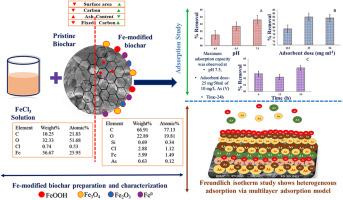当前位置:
X-MOL 学术
›
J. Clean. Prod.
›
论文详情
Our official English website, www.x-mol.net, welcomes your
feedback! (Note: you will need to create a separate account there.)
Arsenic Removal using De-oiled Mentha Biomass Biochar: Adsorption Kinetics and the Role of Iron Modification
Journal of Cleaner Production ( IF 9.7 ) Pub Date : 2024-11-17 , DOI: 10.1016/j.jclepro.2024.144247 Sampurna Nand, Saroj Kumar, Bhanu Pratap, Divya Dubey, Mariya Naseem, Anju Patel, Siddharth Shukla, Pankaj Kumar Srivastava
Journal of Cleaner Production ( IF 9.7 ) Pub Date : 2024-11-17 , DOI: 10.1016/j.jclepro.2024.144247 Sampurna Nand, Saroj Kumar, Bhanu Pratap, Divya Dubey, Mariya Naseem, Anju Patel, Siddharth Shukla, Pankaj Kumar Srivastava

|
Arsenic contamination in water threatens millions of people globally, demanding the development of sustainable and effective remediation strategies. This work investigates the removal of As(V) using Fe-modified biochar derived from de-oiled Mentha waste (MMBC). The study aimed to synthesize MMBC and evaluate its adsorption capacity; secondly, to investigate adsorption kinetics; and lastly, to elucidate the governing mechanisms behind the process. Proximate analysis revealed MMBC's stability (low moisture: 6.48%, high fixed carbon: 54.7%) and high adsorption potential (low volatile matter: 9.77%). Characterization techniques (SEM-EDX, XRD, FTIR, TGA) confirmed a desirable porous structure, favourable chemical composition, and surface functionality critical for As(V) adsorption. Importantly, MMBC exhibited a significantly larger surface area providing more active sites (378.08 m2 g⁻1) as compared to the unmodified biochar. Concerning operational conditions, the optimal As(V) removal was achieved at pH 7.5 with a 25 mg/50 mL MMBC dosage in a 24 h contact time. Further, kinetic modelling indicated a pseudo-second-order mechanism, suggesting chemisorption as the dominant process. However, isotherm studies revealed favourable multilayer adsorption, with the Freundlich model best describing the data. The combined effects of MMBC's porosity, functional groups, and Fe modification facilitated both physical and chemical adsorption mechanisms. These findings highlight MMBC's potential as a promising biochar-based adsorbent for efficient As(V) removal from contaminated water for sustainable remediation.
中文翻译:

使用脱油薄荷生物质生物炭去除砷:吸附动力学和铁改性的作用
水中的砷污染威胁着全球数百万人,需要制定可持续和有效的补救策略。这项工作研究了使用脱油薄荷废料 (MMBC) 衍生的 Fe 改性生物炭去除 As(V)。该研究旨在合成 MMBC 并评价其吸附能力;其次,研究吸附动力学;最后,阐明该过程背后的管理机制。近似分析揭示了 MMBC 的稳定性 (低水分:6.48%,高固定碳:54.7%) 和高吸附潜力 (低挥发性物质:9.77%)。表征技术(SEM-EDX、XRD、FTIR、TGA)证实了理想的多孔结构、有利的化学成分和对 As(V) 吸附至关重要的表面功能。重要的是,与未改性的生物炭相比,MMBC 表现出明显更大的表面积,提供了更多的活性位点 (378.08 m2 g⁻1)。关于操作条件,在 pH 值为 7.5 时,在 24 h 接触时间内以 25 mg/50 mL MMBC 剂量实现最佳 As(V) 去除。此外,动力学模型表明存在伪二级机制,表明化学吸附是主导过程。然而,等温线研究揭示了有利的多层吸附,Freundlich 模型最能描述数据。MMBC 的孔隙率、官能团和 Fe 改性的综合作用促进了物理和化学吸附机制。这些发现突出了 MMBC 作为一种有前途的生物炭基吸附剂的潜力,可从受污染水中有效去除 As(V) 以实现可持续修复。
更新日期:2024-11-17
中文翻译:

使用脱油薄荷生物质生物炭去除砷:吸附动力学和铁改性的作用
水中的砷污染威胁着全球数百万人,需要制定可持续和有效的补救策略。这项工作研究了使用脱油薄荷废料 (MMBC) 衍生的 Fe 改性生物炭去除 As(V)。该研究旨在合成 MMBC 并评价其吸附能力;其次,研究吸附动力学;最后,阐明该过程背后的管理机制。近似分析揭示了 MMBC 的稳定性 (低水分:6.48%,高固定碳:54.7%) 和高吸附潜力 (低挥发性物质:9.77%)。表征技术(SEM-EDX、XRD、FTIR、TGA)证实了理想的多孔结构、有利的化学成分和对 As(V) 吸附至关重要的表面功能。重要的是,与未改性的生物炭相比,MMBC 表现出明显更大的表面积,提供了更多的活性位点 (378.08 m2 g⁻1)。关于操作条件,在 pH 值为 7.5 时,在 24 h 接触时间内以 25 mg/50 mL MMBC 剂量实现最佳 As(V) 去除。此外,动力学模型表明存在伪二级机制,表明化学吸附是主导过程。然而,等温线研究揭示了有利的多层吸附,Freundlich 模型最能描述数据。MMBC 的孔隙率、官能团和 Fe 改性的综合作用促进了物理和化学吸附机制。这些发现突出了 MMBC 作为一种有前途的生物炭基吸附剂的潜力,可从受污染水中有效去除 As(V) 以实现可持续修复。


















































 京公网安备 11010802027423号
京公网安备 11010802027423号